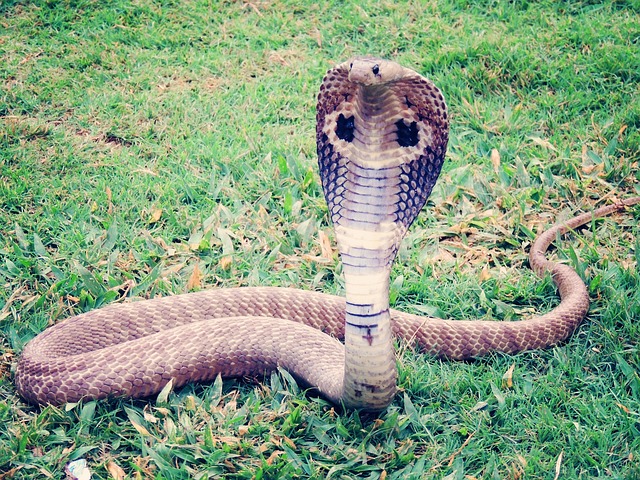The king cobra (Ophiophagus hannah) is a fascinating and highly revered snake, known for its size, intelligence, and iconic hood. Below is a detailed overview of this extraordinary reptile:
The king cobra is the longest venomous snake in the world, capable of reaching lengths up to 18 feet (5.5 meters), though average lengths are typically between 10-13 feet (3-4 meters). Despite its size, it is agile and swift, making it a formidable predator.

Physical Characteristics
- Coloration: King cobras vary in color depending on their geographic location. They can be olive green, tan, or black, with pale yellow or white crossbands running along their body.
- Hood: When threatened, the snake raises its anterior body and spreads its hood, which is created by the extension of its neck ribs.
- Head: It has a broad, flattened head with large, prominent eyes and round pupils.
- Scales: Its smooth scales aid in slithering quietly, enhancing its stealth during hunts.
Habitat and Distribution
The king cobra is native to South and Southeast Asia. It thrives in a variety of habitats:
- Rainforests
- Mangroves
- Plains
- Scrublands
- Agricultural areas
Countries where it is commonly found include India, Bangladesh, Myanmar, Thailand, Malaysia, Indonesia, the Philippines, and southern China.
Diet and Hunting Behavior
The king cobra is primarily ophiophagous, meaning it feeds on other snakes. Its diet includes:
- Non-venomous snakes
- Venomous snakes such as kraits and cobras
- Occasionally lizards, small mammals, and birds
Hunting Method
- The king cobra uses its keen eyesight (it can detect movement from nearly 330 feet away) to locate prey.
- It strikes quickly and delivers venom through its fangs.
- Its venom contains neurotoxins that paralyze prey, and it may also use constriction to subdue larger victims.
Venom
The king cobra’s venom is potent but not as toxic, drop-for-drop, as that of some smaller venomous snakes. However, its large size allows it to inject a substantial amount of venom in a single bite. The venom primarily contains:
- Neurotoxins: Affect the nervous system, leading to paralysis and respiratory failure.
- Cytotoxins: Cause localized tissue damage.
A bite can be fatal to humans if untreated, though the snake often avoids humans and bites only when provoked.
Behavior and Temperament
King cobras are known for their intelligence and complex behaviors:
- Defensive Display: When threatened, they hiss loudly and raise a significant portion of their body upright, making eye contact with the threat.
- Non-aggressive: Despite their fearsome reputation, king cobras are shy and will avoid confrontation if possible.
- Territoriality: Unlike many snakes, king cobras can be territorial, particularly during breeding season.
Reproduction
- Breeding Season: Typically occurs between January and April.
- Nesting: The king cobra is unique among snakes as it builds nests. Females gather leaves and vegetation to construct a mound where they lay 20-50 eggs.
- Parental Care: The female guards the nest aggressively until the eggs hatch, a rare behavior among snakes.
- Hatching: The young are born fully equipped with venom and are about 18-22 inches (45-55 cm) long.
Cultural and Symbolic Significance
The king cobra holds a prominent place in the mythology, folklore, and cultures of many Asian countries:
- In India, it is associated with deities like Shiva and Vishnu.
- It symbolizes power and protection in many Southeast Asian traditions.
- Its image is often used in traditional dances, art, and rituals.
Conservation Status
The king cobra is classified as Vulnerable on the IUCN Red List due to:
- Habitat loss caused by deforestation and agricultural expansion.
- Persecution from fear or retaliation.
- Exploitation for traditional medicine and the pet trade.
Conservation efforts include habitat protection, anti-poaching measures, and raising awareness about the snake’s ecological importance.
Interesting Facts
- The king cobra’s name, Ophiophagus hannah, means “snake eater.”
- It can live for up to 20 years in the wild.
- King cobras have a special structure in their throats called a “tracheal diverticulum” that allows them to produce a loud, deep hiss.
- It is the national reptile of India.
- Despite its venomous bite, it is sometimes kept by snake charmers due to its relatively docile nature under controlled conditions.


